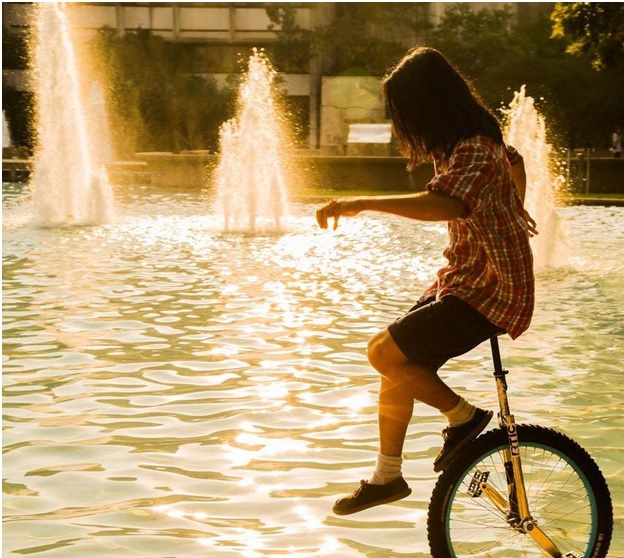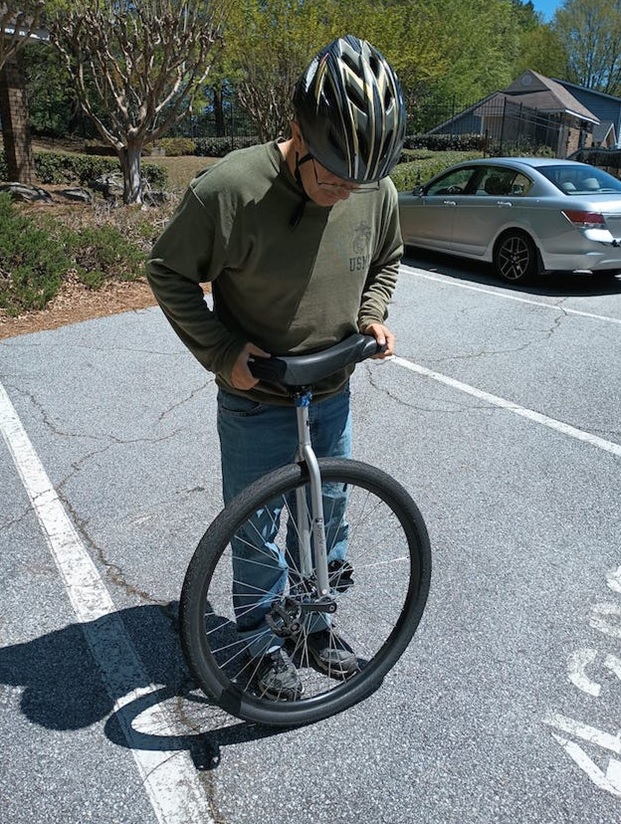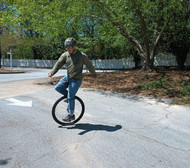Well-Known (but Basic) Unicycle Skills/Tricks to Master
04/18/23
Have you gotten comfortable with mounting your unicycle and riding it forward?
The next step is to try out some of these tricks for size (some might call them skills rather than tricks).
Nonetheless, knowing how to perform some of these will open the door to more advanced tricks and riding.
So, with no further ado…
Idling: The Foundation of Unicycle Skills
If you want to learn any of the subsequent skills, the first thing you’ll want to learn how to do is idle your unicycle.
Idling is basically rocking back and forth, with the ability to stop and start riding at will. It is the jumping-off point for many other tricks and skills.
Moreover, being able to idle will demonstrate greater skill in the handling and control of the unicycle.
Just be aware: before you attempt to idle, you need to be able to ride and be able to free mount. If you can do those two things, you’re set to try your hand at idling.
With that said, it helps if you have something to hold onto. Mount the unicycle, keeping a firm grip on whatever you’re using for support, and rock backward and forward with your dominant foot.
All the pressure should go through your dominant foot; that is the one you should use to control the process of idling.
Rock between the 3 and 9 o’clock position. At first, you’ll probably be rocking back and forth in a more exaggerated fashion, but as you get comfortable, it will become easier and more fluid.
Practice this until you can comfortably idle back and forth without any supplementary support.
One-Foot Riding
Once you master the skill of idling, you may want to graduate to the basic skill of one-foot riding.
This basic skill is exactly what it sounds like, with no tricks here: it’s the ability to remove one foot from the pedal while remaining in control of the unicycle with the other foot.
The first step to one foot riding is to idle; while idling, remove your non-dominant foot from the pedal and rest it on the unicycle’s frame. This should be fairly easy since you shouldn’t be using your non-dominant to power the idle, anyway.
(A square frame on a unicycle is helpful here as it gives you a place to rest your non-dominanty foot, by the way.)
It also helps to do this on smooth, level ground - don’t try it on grass or uneven ground.
Get starting riding forward, and as your non-dominant foot comes to the top of rotation, remove it from the pedal and rest it on the frame.
Use your momentum to continue powering forward with your dominant foot. It will be a little jerky and difficult when you start but as you become more comfortable riding, it should get easier.
Just be aware: you’re going to fall off a lot while you’re practicing - just don’t give up.
Wheelwalking

Another unique skill to master after learning to idle is wheelwalking, which is the process of manipulating the wheel using your feet on the tire, directly.
To do this, it helps to have a wall or rail on one side to help with stability.
To wheelwalk, remove one foot (your dominant foot, preferably) from the pedal and place it flat on the tire, in line with it. Do not point your toe in or out across the tire.
Use it to push the tire forward, and then as it passes forward along the tire, opening up room, bring your other foot up and onto the tire behind it.
Make sure there is a gap between them because if you move your second foot onto the tire too quickly before there is room you may get tripped up and experience an unplanned dismount.
One more tip: bringing your legs in front of you like this will throw off your balance. Therefore, it helps to lean back slightly to counteract this change in your center of gravity.
Coasting
Coasting on a freewheel unicycle is relatively easy because you can do it without removing your feet from the pedals. It is difficult in all other aspects though, due to not having the ability to correct your center balance over the wheel due to the hubs freewheel ability, a brake is best used in this application.
But on a unicycle in which the crank arms are fixed to the hub axle, it’s a bit more difficult. You can still do it, though.
Just be aware that you shouldn’t try this at slow speeds as it will be a lot harder to balance. It’s best to try this after being able to get up to a few miles per hour, at least.
To coast, lift your feet out of the pedals and onto the crown, one at a time, not both at once.
Some riders contact the tire with one or two toes in order to moderate speed, especially if on a downgrade, to prevent loss of control.
Moderating unicycle speed by contacting the tire with one toe will also help with recovering to the pedals.
“Seat Drag”
“Seat Drag,” in which the rider pulls the saddle out in front of him or her while continuing to ride, is another basic (but slightly more intermediate) skill to master before proceeding to more advanced tricks.
To do this, it helps to have a wall or rail next to you that you can hold onto for stability (you should notice a trend here with this).
When your feet get to the 3 and 9 o’clock positions, stand up straight, lifting yourself out of the saddle, and then pull the saddle forward.
You can hold onto the front or back of the saddle for stability as you do this; to reverse it and get back into the saddle, get your feet back into the 3 and 9 o’clock positions and then lift yourself again, pull the saddle back you, and sit down.
It sounds easier than it is, and it will take a bit of practice, but keep at it and you’ll master it before long.
Make Sure Your Unicycle Is Adjusted Appropriately

One thing to keep in mind is that you need to make sure your unicycle saddle is at the proper height before you attempt any of these skills or tricks. Remember, you can adjust the seat tube up or down by loosening the unicycle/bike seatpost clamp and raising or lowering the saddle.
Remember, though, you can only adjust the saddle height so much through the unicycle/bike seatpost clamp. If you need to lower your saddle further, you may need to cut down your seat tube - see the previous link for more information on how to do that with either a hacksaw or a pipe cutter.
Questions? Contact Us
If you have any questions about how to tackle any of these skills, how to cut down your seat tube, or how to replace your unicycle/bike seatpost clamp, contact us.
We are here to help. You can reach us at 678-494-4962.

